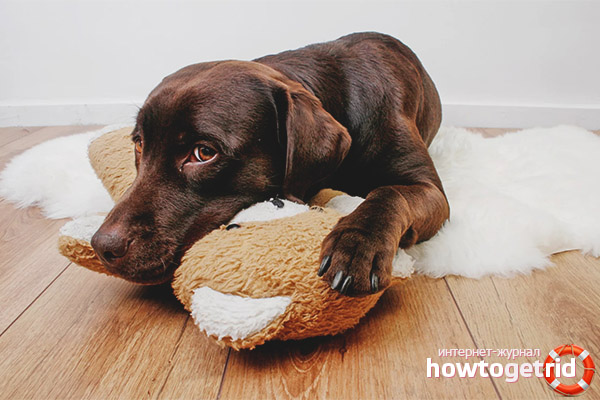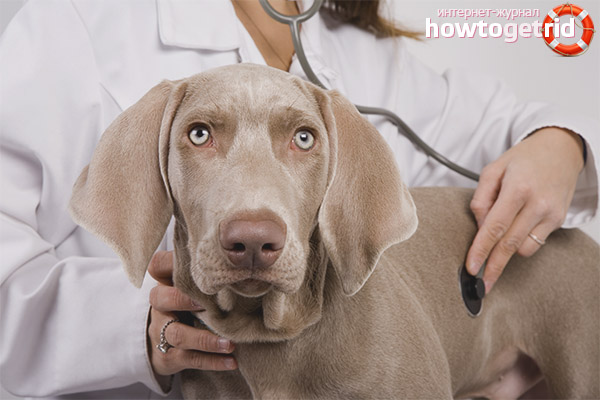The content of the article
All dogs sometimes get sick, but not always the owners can determine it on time, because the animals are very hardy and do not immediately pay attention to changes in the body. Even if pain has begun in the belly of the pet, he can frolic, run and naughty, not paying attention to the malaise that has begun.
The whole danger lies in the fact that only when the process has developed quite strongly, painful cramps worsened, the dog begins to show symptoms. As a rule, she begins to whine plaintively. And only at the reception of the veterinarian, the owner is surprised to learn that the disease lasts a long time.
Nevertheless, at the early stage, the onset of the disease can also be determined, but the owner is required to be more attentive to the pet, sensitively reacting even to small unusual changes in behavior.
What to look for?
The most important symptoms that suggest that you need to urgently consult a veterinarian:
- Complete lack of appetite, refusal to try the most favorite food. If this happens, most often it signals a digestive problem.
- Interest in outdoor games has disappeared. The pet goes out for a walk very reluctantly, on the street does not show interest in the surrounding animals, often stops or lies down and does not want to get up.
- If you press on the stomach, the pet may whine or show unexpected aggression. Even a friendly dog can change during an illness, and keep people away from him, trying to bite. Such behavior cannot be punished, since it is severe pain that causes irritability and aggressiveness.
- The dog stopped communicating with the household, huddled in a corner and moaning plaintively. She doesn’t want to go out for a walk at all.
- The changed gait. The dog walks very slowly, most often hunched over or lifting the back while moving and constantly whimpering.
- The animal periodically flinches from pain.
If there are such changes in behavior, you should check the physiological state:
- Does the pet have diarrhea or constipation. The chair may be too frequent and watery or, conversely, rare. If such pathologies are found, gases constantly accumulate - which means that the gastrointestinal tract needs urgent examination and treatment.
- What happens after the next meal: the disease progresses if vomiting begins after eating, the leftover food comes out in large pieces, undigested, or mucus appears.
- It smells bad from the mouth, the smell is putrid.
- The nose is warm.
- Eyes begin to turn sour.
- The abdomen is noticeably swollen and hard.
To help your pet, you will need the help of a veterinarian.
What can cause abdominal pain
Before starting treatment, the veterinarian must make an accurate diagnosis. The causes of disturbances and pain can be many. In most cases, it is either food poisoning, which is quickly treated and disappears without a trace after therapy, or improper or irregular nutrition. But serious pathologies also happen if, for example, a tumor develops in the abdominal cavity, a dangerous infection enters the body, or the disease is predetermined by a genetic predisposition.
Some stomach problems can be avoided. But for this you should know that abdominal pain may appear due to:
- Helminthic infestation.
- Poisoning. It can be caused by poor-quality products, especially in the summer, when viruses and bacteria develop faster.Some dogs like to pick up a discarded bone on the street or, until the owner sees it, visit a public trash. As a result, inflammatory processes begin to appear on the mucous membranes.
- Penetration of pathogenic microbes into the body. This indicates an intestinal infection, and it is necessary to get rid of it, since the waste products of microorganisms poison not only the intestines and stomach, but also other organs.
- Poor feed. Harmful additives, overdue use provoke the occurrence of diseases.
- Transition to a new type of food. While adaptation takes place, stomach discomfort may occur.
- Food allergies. In dogs, too, there may not be a perception of any product, and an inflammatory process may occur in the wall of the stomach or intestines.
- Ingestion into a foreign body. Even a small object causes cramping and sharp pain.
- Overeating. If the pet likes to eat too hearty, the digestive organs do not have time to process the remnants of food. The stomach swells and begins to hurt, nausea may appear, since the food is a heavy load.
- Rare walks. If the pet is forced to endure for a long time until it is withdrawn, the act of defecation is violated. As a result, feces become denser, which leads to injuries of the intestinal mucosa, the development of inflammation and the occurrence of pain.
- Damage to internal organs if a mechanical injury occurs.
Periodic pain can occur if the dog is used to eating food from the bowl too quickly. Food enters the empty stomach rapidly, which provokes the appearance of spasms.
If a dog is found to have pancreatitis, then with improper nutrition, severe abdominal pain appears, the pet's appetite disappears, it becomes very lethargic. Impaired pancreatic function often provokes not only pain, but also constipation.
A disease such as cystitis is also a cause of abdominal discomfort. Inflammation of the urethra causes pain in the lower abdomen. And if this disease is not started to be treated on time, the dog may become inflamed.
There are pains in the abdomen, if the dog had to be treated with various drugs for a long time, as a result of which intestinal dysbiosis occurred, that is, the ratio of microflora in it was disrupted. This means that the processes of decay have intensified, harmful substances are accumulating more and more, and the motor activity of this organ is sharply reduced. This most often leads to constipation, which also contributes to the occurrence of pain.
In the diet of dogs, veterinarians do not recommend including some products that may provoke the appearance of colic, bloating and increased gas formation. These include, first of all, cereals - pearl barley and corn, as well as a family of legumes and sweets from dough.
Is there any cause for concern?
If a pet is concerned about pain due to an improper diet, then they will disappear if properly balanced. It will take several days to recover, and treatment in this case is basically not necessary.
But, if pain occurs for a long time, the dog’s stomach is hard, and when the owner tries to touch the place that worries the pet so much, he hears a growl in response, then it's time to visit the veterinary clinic. Only timely assistance of a specialist will help to understand the problem and cure your pet.
Why home treatment does not help?
A common mistake of pet owners is to try to cure them at home. The dog is given activated charcoal, rehydron, no-shpu, make cleansing enemas. Indeed, these methods help, but only for a short time. And then all the symptoms of the disease in most cases return.
Medications can be harmful if given to an animal before being taken by a veterinarian, as pain will be reduced and an accurate diagnosis will be difficult to establish.
To help the animal at home, before the examination of the veterinarian, you can do a light massage, be sure to clockwise, if this makes the dog feel better. You can use a slightly heated flannel fabric for massage.
Visit to a specialist
For proper treatment, a comprehensive examination of the patient of the veterinary clinic should take place. Sometimes it’s enough to feel the abdominal cavity to determine if a tumor has arisen there or if an intestinal obstruction has appeared.
But most often the veterinarian offers a more detailed examination to determine the diagnosis:
- Take a urinalysis to the laboratory to find out the presence of bacteria and white blood cell count.
- Bacterial culture of urine. This will make it possible to determine the causative agent of the disease.
- Ultrasound Such an examination allows you to find violations in the work of internal organs.
Additional studies may also be needed, for example, x-rays, blood and feces.
If the veterinarian finds out that the pain is caused by food poisoning, or if feeding was carried out incorrectly for a long time, diet therapy and pills are prescribed. They are selected depending on the characteristics of the dog breed. Injections may also be prescribed.
Depending on the diagnosis, antimicrobial and anti-inflammatory drugs can be prescribed to remove inflammation.
Surgical intervention is usually required only in cases where an object has appeared in the stomach or a tumor needs to be removed.
Prevention is important!
- You need to feed the dog only with fresh, high-quality food, excluding fried, smoked and fatty foods. From a very young age, it is necessary to wean a pet from raising food leftovers or any objects on the street.
- To save a pet from worms, every six months you need to give him a special pill.
- When walking, you should ensure that the animal is not injured, otherwise damage to internal organs can cause many diseases.
Veterinarians warn that abdominal pain in dogs cannot be ignored, and the sooner therapy is prescribed, the faster the pain will pass.
Video: gastrointestinal tract diseases in dogs











Submit